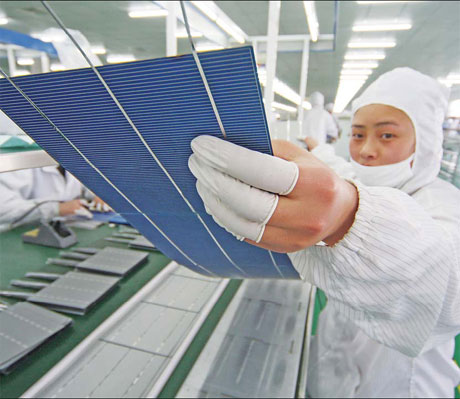Time under the sun
Updated: 2011-06-03 11:12
By Fu Jing (China Daily European Weekly)
|
|
Solar energy to gain ground in wake of Japan's nuke crisis
China has chalked out an ambitious plan to bridge the solar power gap with Europe and increase solar power installations to 50 gigawatts (gW) by 2020.
Li Junfeng, deputy director of the Energy Research Institute affiliated to the National Development and Reform Commission, China's top economic planning agency, says China has set solar installation targets of 10 gW and 50 gW by 2015 and 2020 even as the government is putting the finishing touches to the energy development blueprint for the next five years
The nation's top legislature has already approved the country's 12th Five-Year Plan (2011-2015) in March and it is likely that the government may come out in July with energy development schemes for the next five years in July.
Compared with China's current solar installation capacity of less than 1 gW, the targets are ambitious and will help create a new robust solar power market in China after Europe.
"Over the next three to five years, China, the United States and India will become the major markets for solar power after Europe," says Li.
The huge market potential will also require Chinese photovoltaic (PV) makers to sharpen their core competitiveness in the industry chain right from the raw material production stage such as polysilicons to power plant construction.
Though much of China's solar focus will be on exploring the domestic market, Europe will continue to maintain the momentum as the global leader in developing solar power for some time. With concerns mounting over nuclear power in the aftermath of the nuclear disaster in Japan, there has been wariness toward the clean energy source.
Germany on May 30 announced plans to become the first major industrialized power to shut down all its nuclear plants in the wake of the disaster in Japan, with the phase-out due to be wrapped up by 2022.
It means that the country will have to find the 22 percent of its electricity needs currently covered by nuclear reactors from another source.
The Brussels-based European Photovoltaic Industry Association (EPIA) forecasts that by 2015, globally installed PV systems will reach from more than 130 gW to 200 gW. In coming years, solar photovoltaic power is well on the way to becoming a fully competitive part of the electricity system in the European Union and an increasingly important part of the energy mix around the globe.
"The evolution of the PV market in recent years has been heavily linked to the confidence and vision of smart policymakers in supporting the development of the technology," says Ingmar Wilhelm, EPIA president. "Adequate support policies that have been driving the markets so far, such as the feed-in tariffs, must continue and be ever brought in tune with the declining cost curve of PV."
According to EPIA's report, the PV market experienced unprecedented growth in 2010, with capacity additions growing from 7.2 gW installed in 2009 to 16.6 gW in 2010. The total installed capacity in the world now amounts to around 40 gW, producing some 50 terawatt-hours (tWh) of electrical power every year.
Germany and Italy had a rapid growth in 2010 by offering substantial fiscal subsidies to support solar power plants though they have curtailed the incentives this year because of fiscal austerity.
With 7.4 gW installed last year, Germany continues to lead the PV market worldwide, while Italy, with an installed capacity of 2.3 gW, has started to exploit its huge potential for solar resources, says the EPIA. In the EU, more than 13 gW of new PV capacity was added last year, while the rest of the world accounted for almost 4 gW.
Due to relatively low human cost, China has become a major assembly line for solar equipment. Nearly 70 percent of the global PV demand in 2010 was met by production in China though currently the country's installed equipment for generating solar energy has a capacity of less than 1 gW.
E-paper

Pearl paradise
Dreams of a 'crazy' man turned out to be a real pearler for city
Literary beacon
Venice of china
Up to the mark
Specials

Power of profit
Western companies can learn from management practices of firms in emerging economies

Foreign-friendly skies
About a year ago, 48-year-old Roy Weinberg gave up his job with US Airways, moved to Shanghai and became a captain for China's Spring Airlines.

Plows, tough guys and real men
在这个时代,怎样才"够男人"? On the character "Man"

